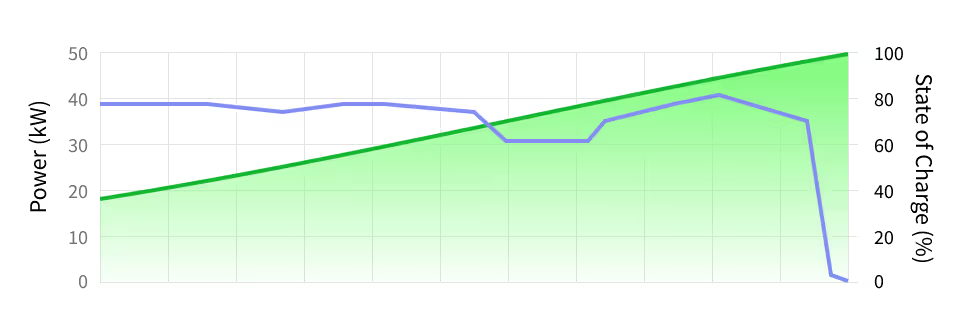Six factors that affect EV charging time
Fleet managers are responsible for ensuring that drivers and vehicles are where they need to be, and that operations run on time. When fleets adopt electric vehicles, fleet managers need to account for a major scheduling complication: EVs take significantly longer to charge than gas or diesel vehicles do to fuel. For example, if a fleet manager needs an EV to leave right now on a route, and the EV has low battery, the route start could be delayed by an hour or more.
Flipturn provides a few tools to better manage and plan EV charging, including predicting the time at which an EV will be finished charging. To estimate charging time accurately, Flipturn looks at both historical data and a number of other factors that impact charging. In this blog post, we explore the factors that influence the charging time for your EV, peeking under the hood at Flipturn’s prediction algorithm.

1. The charger’s power limit
Charging stations come with various power outputs, measured in kilowatts (kW). The higher the charger's power output, the faster your EV's battery can be charged.
Even if your charger’s power rating is high, your vehicle is not guaranteed to charge at that maximum kW rating. If your EV has a lower charging capacity than the charger, it may not be able to take full advantage of the charger's output. We’ve also seen chargers that consistently charge a few kW below their power rating, chargers that consistently charge above their manufacturer-provided power rating, and chargers that oscillate in power output regularly throughout a single charging session. So, while the power limit of a charger is an important factor, it alone cannot be used to calculate when an EV will be fully charged.

2. The vehicle's battery size
The battery size of an EV directly impacts its charging time. Batteries with a higher kWh capacity may enable longer range, but they require more time to charge fully. Charging a passenger EV with a level 2 charger is feasible; charging a heavy duty EV truck with a level 2 charger may take days.
3. The vehicle’s maximum charge rate
Just like charging stations, EVs have their charging limits, often referred to as the vehicle's "charge rate" and measured in kW. This limit represents the maximum rate at which your EV can accept electricity for charging. If your vehicle's charge rate is higher than the charging station's maximum output, it will charge at the charger’s maximum capacity. On the other hand, if the vehicle's charge rate is lower than the station’s maximum output, your EV will charge at its limit, leading to longer charging times.
4. Vehicle settings that throttle charging above a certain state of charge
Either the vehicle or the charger may throttle (reduce) the charging speed once the battery reaches a certain state of charge threshold, allowing for a more controlled and gentle charging process. This is done to protect the battery from overcharging, which can be detrimental to its health and longevity.
Throttling behavior can vary by vehicle make and model. For many light duty models, throttling can begin at around 80% state of charge. For heavy duty vehicles, we typically see thresholds of 90-95%, above which charging slows significantly.

5. Temperature
Extreme temperatures, both hot and cold, significantly impact battery performance and charging speed. In cold weather, the battery's internal resistance increases, making it more challenging for the charger to deliver energy efficiently. Similarly, in hot weather, the battery may need more time to cool down before charging to avoid overheating.
Many modern EVs and charging stations are equipped with thermal management systems that regulate battery temperature during charging, improving overall charging efficiency. However, these systems take time to warm up, which could impact charging times unpredictably.
6. Charging management power limits
Flipturn offers charging management tools as part of its end-to-end EV fleet management platform. Charging management restricts the power output of your chargers, with the goal of both saving you money on your utility bill and preventing you from exceeding the power capacity of your site.
There are two main categories of charger management, charger-specific limits and site limits, which affect charging speed in different ways.
Charger limits. Some charging management systems allow configuring limits on the power emitted by each charging port. For example, fleet managers use Flipturn to minimize charging between 4pm and 9pm, when time of use rates are high. We’ve also seen charging throttled overnight, when vehicles have more time to charge, because charging at higher speeds is worse for battery health.

Site limits. A site power limit can be jointly applied across all EV charging stations on that site, and prevents the total power usage of all of the chargers from exceeding the specified limit. As the power demand from chargers waxes and wanes, a charger management system will load balance across all in-use chargers, so that vehicles are evenly charged.
So, when a site limit is in place, each vehicle can impact all other vehicles’ charging times. Whenever a vehicle starts charging or gets prioritized to charge quickly, the power delivered by all other chargers on the site might be throttled, prolonging every other charging session.

Conclusion
As EV fleets grow, accurately predicting charging times becomes even more critical. For example, if two vehicles are sharing a charger, incorrectly predicting when one vehicle will be charged might delay both vehicles from leaving on time. Fleet managers need to know whether to tell a driver to wait for their EV to finish charging, or to just pick up and leave in a different vehicle altogether.
At Flipturn, we’re focused on helping fleet managers efficiently and effectively run their EVs and chargers. Through Flipturn’s unified platform, you can get visibility into EV charging times, power usage, range, and more, so you can seamlessly scale your investment in EVs.
Click here to schedule a demo and learn more!






